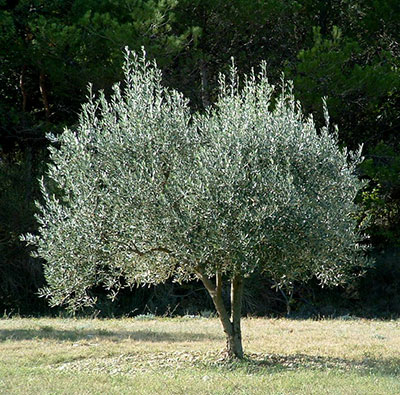Olives

Think of olive trees and you may think of the Mediterranean, but did you know that you can grow olives in Florida? These fruits have a rich history—from appearing in ancient mythology to the peaceful symbolism of an olive branch.
Characteristics
The olive tree (Olea europaea) is an evergreen native to the Mediterranean, Asia, and Africa. The beautiful silvery foliage will vary in color, but is generally considered to be grayish-green. White flowers appear in April or May in Florida and precede the fruit set.
Olive fruits start out as green and will generally become a blackish-purple color when fully ripe; though some varieties will remain green and others turn a copper-brown color. The shape, size, and flavor characteristics can vary quite a bit as well.
Olives are usually too bitter for eating right off the tree; depending on the variety, some are ideal for preserving and eating later, while others are better suited to be pressed for oil.
Planting and Care
Several other Florida plants are commonly called “olive,” so be sure you’re purchasing a European olive tree if you intend to grow an edible fruit.
While olives have been grown in Florida for years on a small scale, they are a relatively new commercial crop here, so there is still much to be learned about the cultural requirements for keeping healthy and productive trees. Researchers have been testing olive trees as far south as Orlando. Growers further south will have to decide whether it’s worth the chance or wait for more research to be done to see just how far south these trees will grow and thrive.
Floral development (and thus, fruit production) in the olive can be quite complex. Planting more than one cultivar close together may increase fruit set. If you want to jump in and give it a try, the cultivar ‘Arbequina’ from Spain has been the most popular in Florida. It is a self-pollinator, meaning it can use its own pollin to fertilize and produce fruit, but having other cultivars nearby seems to help. ‘Koroneiki’ and ‘Arbosona’ are often planted to support pollination of ‘Arbequina’. ‘Mission’, the common black “table olive” (for eating as opposed to those better for oil), is another cultivar that is self-fertile and may do well in a Florida landscape.
One of the most important landscape considerations for growing olives is soil. Olives grow best in sandy, well-drained areas. The trees actually thrive in poor soil; excessive nitrogen fertilization can cause too much shoot growth at the expense of fruit production. Too much water from irrigation or rain will make trees susceptible to root-rot disease and damage production by causing flowers to drop before they form fruits.
Plant your olive trees in a sunny spot with well-drained soil. Once established they’ll require minimal care, but you will need to protect them if winter temperatures drop below 20 degrees.
Pruning can be tricky. Olive trees never bear fruit in the same place on a stem, so new growth each year is essential for flower production and fruiting. While pruning controls height or form and increases airflow to reduce fungal disease issues, the impacts on flowering and fruiting should be considered before drastic pruning takes place.
You should begin to see fruit on your olive tree after three years. In terms of production, don’t be surprised if your tree seems to take every other year off. Olives are described as alternate-year-bearing species and typically have a year of heavy fruit production followed by a year of lighter production. Take advantage of the lower-producing years by pruning non-flowering branches during the flowering season. When heavier fruiting does take place, thin the crop of olives to two to three fruits per foot of twig. This will increase fruit size. Thinning should be done soon after fruit set.
Olives are considered relatively pest- and disease-free trees, although scale can be a problem, as with many other landscape trees in Florida. Additionally, leaves can be damaged by caterpillars and grasshoppers. Keeping an eye on your tree and addressing any issues early is important to keep it healthy and thriving.
For more information on growing olives, contact your county Extension office. And look for updates from the Florida Olive Council; it’s working with UF/IFAS on olive research.
UF/IFAS Publications
- Olives for Your Florida Landscape
- Pests and Fungal Organisms Identified on Olives (Olea europaea) in Florida
